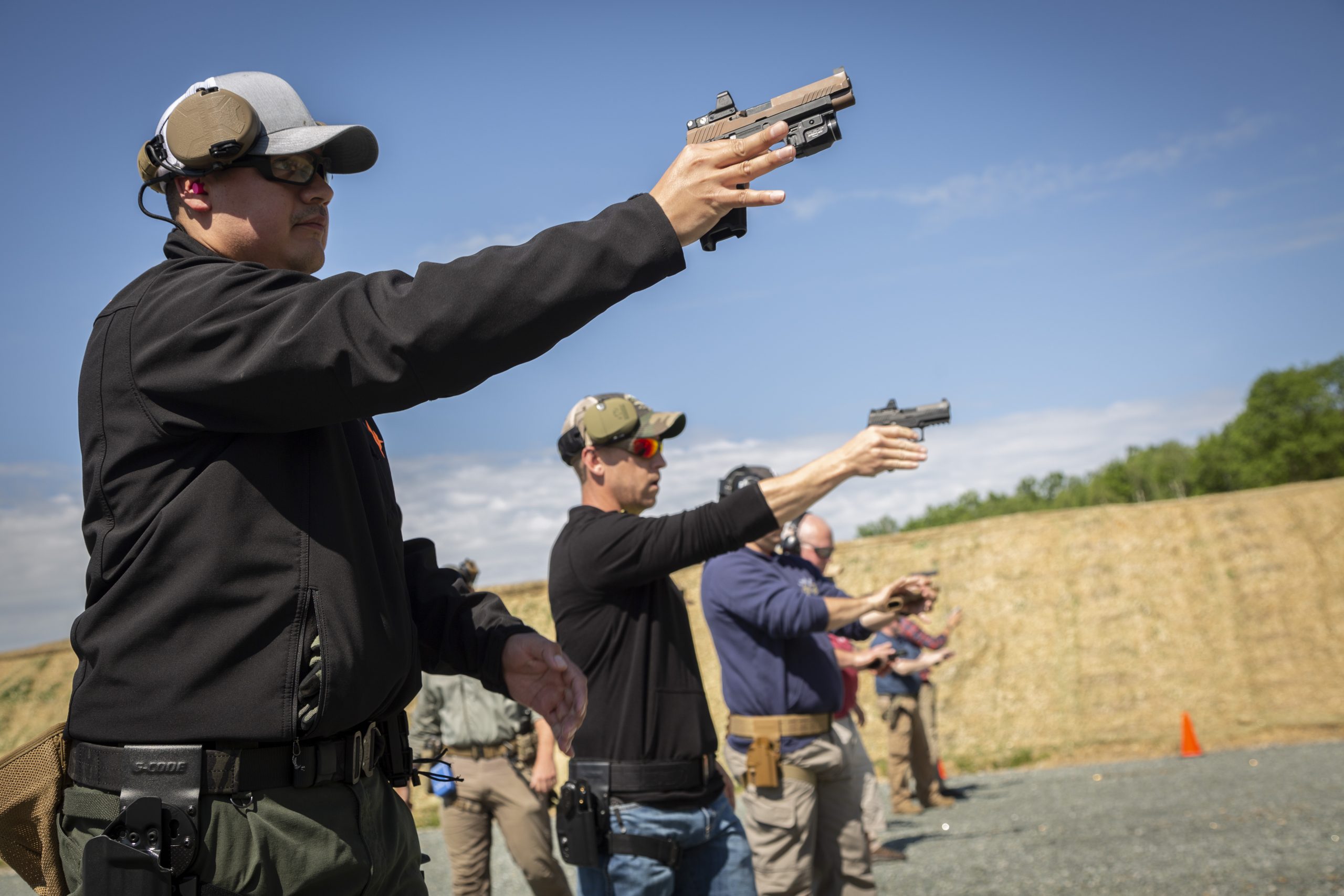Plenty of shooters find themselves stuck in a rut, banging away at paper or steel at the indoor range or in the backyard, trying to get faster and more accurate using YouTube University. If you’re in this situation, looking to expand your skills from passable to proficient, then jumping into an intensive, multi-day pistol training class is The Way.
Attend a Pistol Training Class
Pistol training is a big investment, especially now that ammo prices are through the roof. So, it makes sense to consider what you can expect to learn from a full-on, multi-day pistol class, and how to get the most value from it. We’re talking about something like a 2-day class that’ll have you burning through 800-1000 rounds of ammo and walking away with newly developed skills, the confidence to use them, and some methods to maintain those skills down the road.
Good classes aren’t cheap. Aside from tuition, there’s the cost of ammo, plus travel in most cases. A 2-day course can end up costing $1000 to $2000, easy, these days.
Advertisement — Continue Reading Below
We signed up for a Ridgeline Defense 2-day Combative Pistol class in June 2021 to get a feel for what a “combative” or intermediate pistol class looks and feels like these days. The class teaches students “the fundamentals of pistol engagements with a heavy emphasis on the foundation of accuracy and maximizing the efficiency of their draw stroke.”
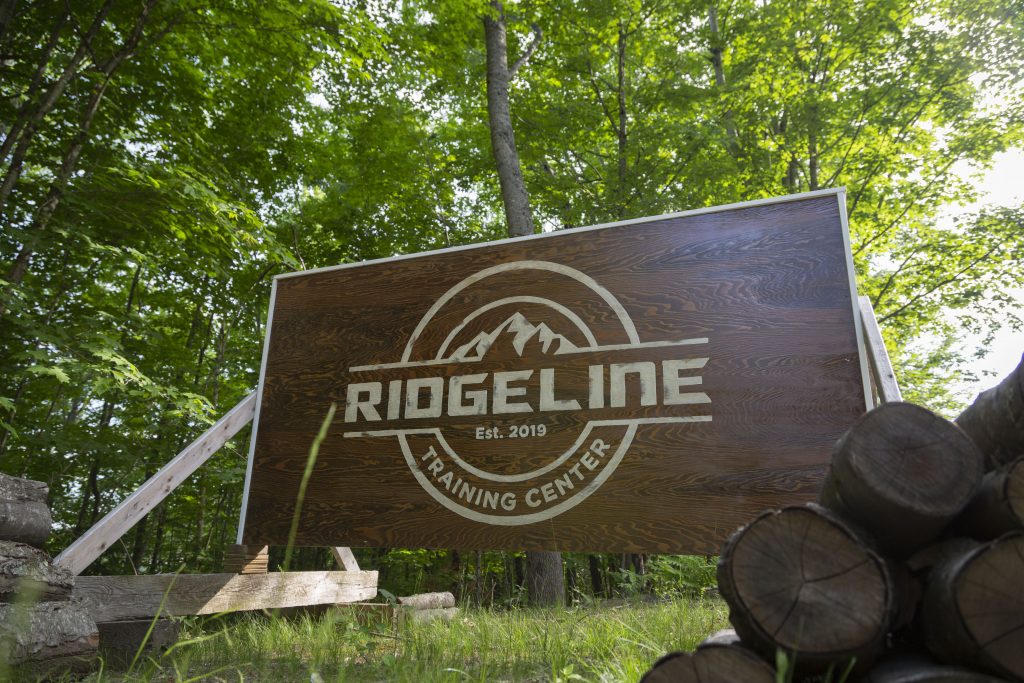
Ridgeline Defense
We chose Ridgeline for a few reasons. First, their location is convenient; just a couple hour drive from us with several motel options nearby. Second, Ridgeline advertises a good instructor to student ratio of four to one. It limits class sizes so students get the attention they’re paying for. Third, this class takes place at their own training facility. This is an important consideration when choosing a class. Traveling instructors can’t compete with the range of targets and facilities offered by home field instructors.
Advertisement — Continue Reading Below
Lastly, we did a little backchannel checking on Ridgeline’s reputation and found out they provide training to some high-end national and international military units thanks to their close relationship with one of the nation’s premier off-road driving schools, Team O’Neil Rally School. You’re going to have to read between the lines to figure out what kind of clientele are attracted to a rally driving school with a shooting school across the street.
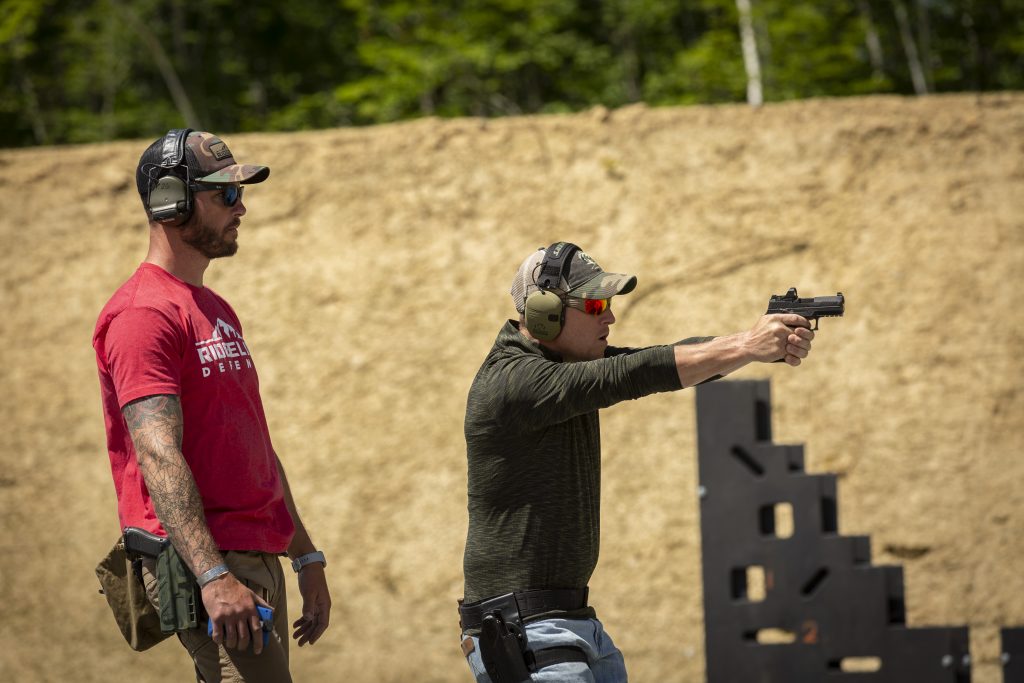
Are You Ready?
Aside from assuming you’re ready for the next level, take a second to consider if you’re ready to absorb everything on offer in the class you’re looking at. At a basic level, make sure you’re qualified for the course of instruction. We’ve attended about a dozen firearm classes over the years. Skill levels often vary widely among the students in each class. We recall a couple times a student proved so over their head that they were asked to audit the rest of the class and return when they’ve gained more comfort and competence with their firearm. It’s a difficult, humbling moment. But even the best instructors can devote only so much time to a floundering individual in class without holding back the rest of the students. Don’t be that student.
Advertisement — Continue Reading Below
Where should you be to get the most from your training investment? Our class with Ridgeline comprised more of an intermediate level class. So we read the prerequisites carefully and confirmed the class was appropriate for us with a phone call.
“You need to have attended at least a fundamental live-fire pistol course and have some practice under your belt,” says Alex Hartmann, Ridgeline Defense’s lead instructor.
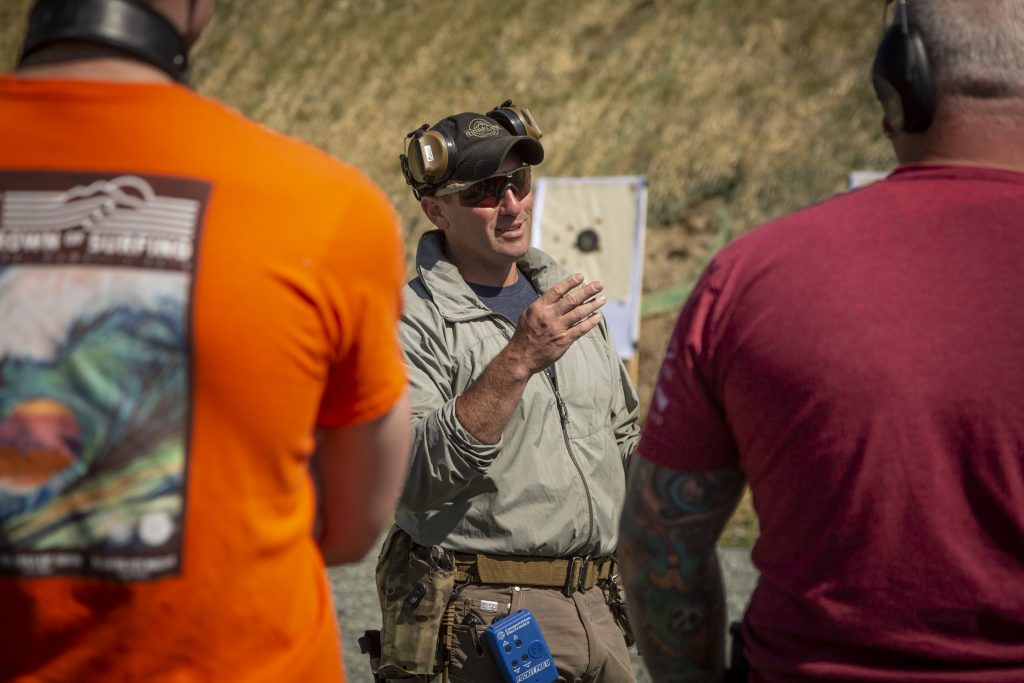
Advertisement — Continue Reading Below
Beyond the Basics
During our conversation, he said taking a one-hour fundamental pistol class at an indoor range doesn’t really make you comfortable, capable, or competent in the use or handling of a firearm. Ideally, for this class, he said it’ll take a couple of those classes plus practice on your own to get you up to the point where you’re truly comfortable manipulating, drawing, reloading, and hitting what you’re aiming at.
We’d call this skill level the beginnings of intermediate pistol proficiency: the ability to run the gun from a holster, making A-zone hits from a standing position at five- to ten-yards, while working at your own pace, plus perform a basic reload. After a brief skills assessment, we felt we met this standard.
If you’re at this level, you’re ready to take a class that puts some pressure on you and teaches you to act sooner, shoot faster, make more accurate hits on smaller targets from further away, and learn to apply these skills while on the move. Aside from leveling up, a multi-day class has the round count and instructor time to lock in some unconscious competence in the key areas of marksmanship and employment speed.
Advertisement — Continue Reading Below
Class Day
When you get to the range, your instructor will greet you and give you a few minutes to unpack some gear. Once the trunk time and small talk is done, it’s time for instructor and student introductions where you should get a chance to tell the training staff what you’re hoping to get out of the class. This sets an important baseline for expectations, giving both you and your instructor a clear goal for the weekend.
Time is money, so hopefully your training staff keeps the in-brief concise and gets you out on the range quickly. Our class had two instructors and eight students that were comfortable with their pistols and the pending course of instruction. So, after a quick, but thorough range safety and medical brief it was time to jam mags and meet up out on the range.
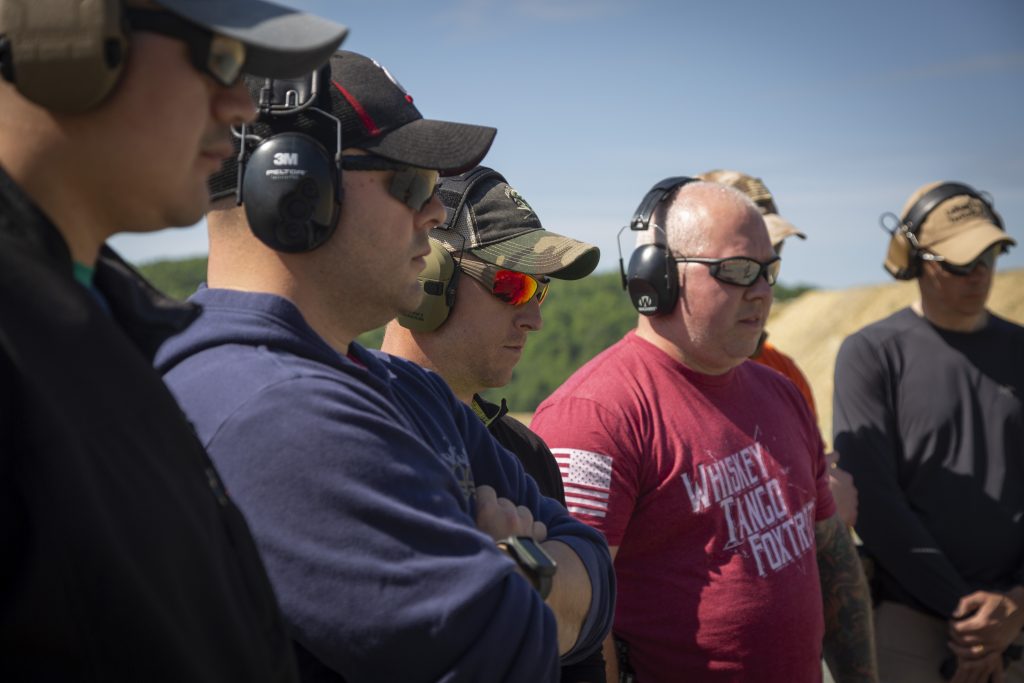
Advertisement — Continue Reading Below
Ammo
The round count for our class was 1000 rounds of 9mm. Ammo is a pain in the ass to get at the moment. So many of the students were glad that Ridgeline offers ammo along with its training package. Signing up for the class, many gladly checked the box for the extra $650 that saw their class ammo waiting for them on arrival. On the other hand, we were lucky enough to have a haul of 115-grain Hornady’s Critical Defense that wasn’t going to shoot itself. No matter what you choose, shoot reliable factory ammo. One of the class students brought his own reloads and had to step away from the class to clear a squibbed barrel. Our Hornady 115-grain Critical Defense ammo ran without a single issue over the two-day class. It ensured we could concentrate on learning to shoot, not clearing dangerous malfunctions.
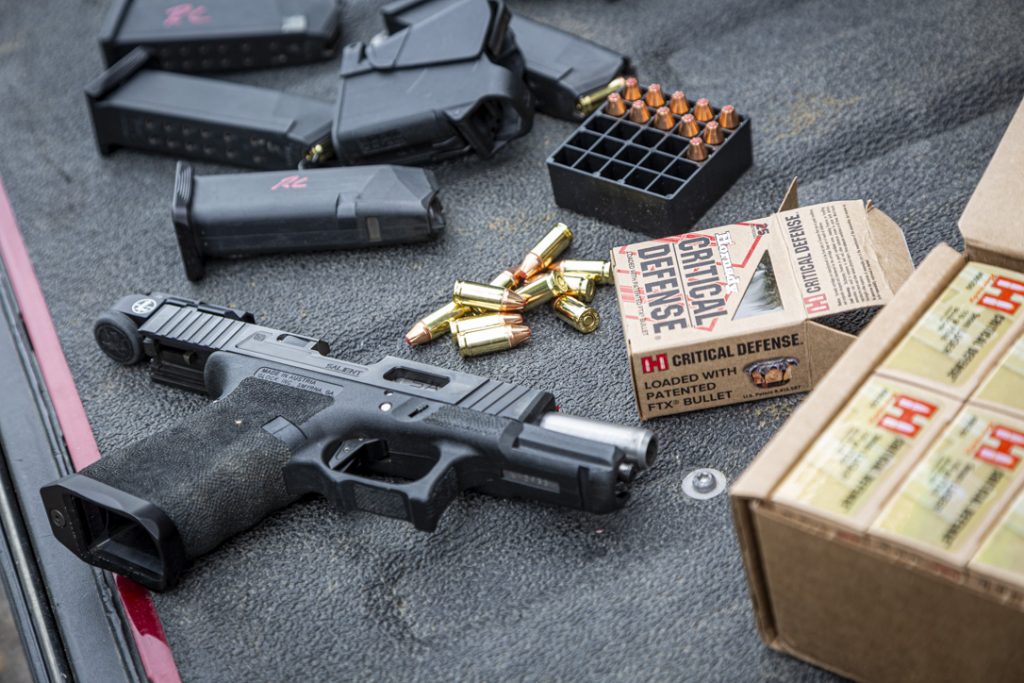
Gear Up
We brought five mags for our Glock 19 and two belt-mounted mag carriers to the class. That’s four mags for the class, plus a spare. Speaking of spares, we also brought a spare pistol. Even though a reputable shooting school likely has a spare on-hand to deal with any problematic gear, we brought our own so that if our primary went down, we’d have valuable trigger time on one of our own guns instead of a school gun that we’d never shoot again. If you’ve got a spare, bring it. Anything can break over the course of 1000 rounds.
Advertisement — Continue Reading Below
Once our gear was roughly sorted, we gathered with the other students and our instructors, Alex Hartmann and Blake Cunningham, for a quick lecture on holster and mag pouch placement. We were running the Glock in an AIWB setup. Other students ran strong-side OWB holsters, with some using drop-leg variants. The instructors lectured the importance of channeling your inner Batman. They checked everyone’s setup, gave some individual pointers, and had tools on hand to help with adjustments.
Training Time
With two loaded mags on my belt, and the other two in a dump pouch attached to my belt at six o’clock, it was time to focus on the basics. Alex gave a 15-minute lecture on fundamentals touching on skills such as stance, grip, sight alignment, sight picture, breathing, trigger control and the meaning of follow through. At this level, much of what was covered in 15 minutes was a review for the class. But it gave everyone something to focus on.
The class got on line at 5 yards and for a series of dry-fire exercises to check point of aim. Then it was time to load up and learn the importance of a good pistol grip. Ridgeline teaches something it calls a cascading grip (a term they attribute to Robert Vogel). It works from the base of the pistol grip to the trigger guard.
Advertisement — Continue Reading Below
The mechanics of the cascading grip itself isn’t anything new, but the way Alex had us build the grip in steps from a single open hand to a two-handed combat grip was enlightening. It began with dry-fire and culminated in live fire with several intermediate skill building drills along the way. Once the class had its collective grip dialed in, the cadre drew witness marks across our hands as a visual reminder we could reference throughout the day to tell if our attention to the grip was waning.
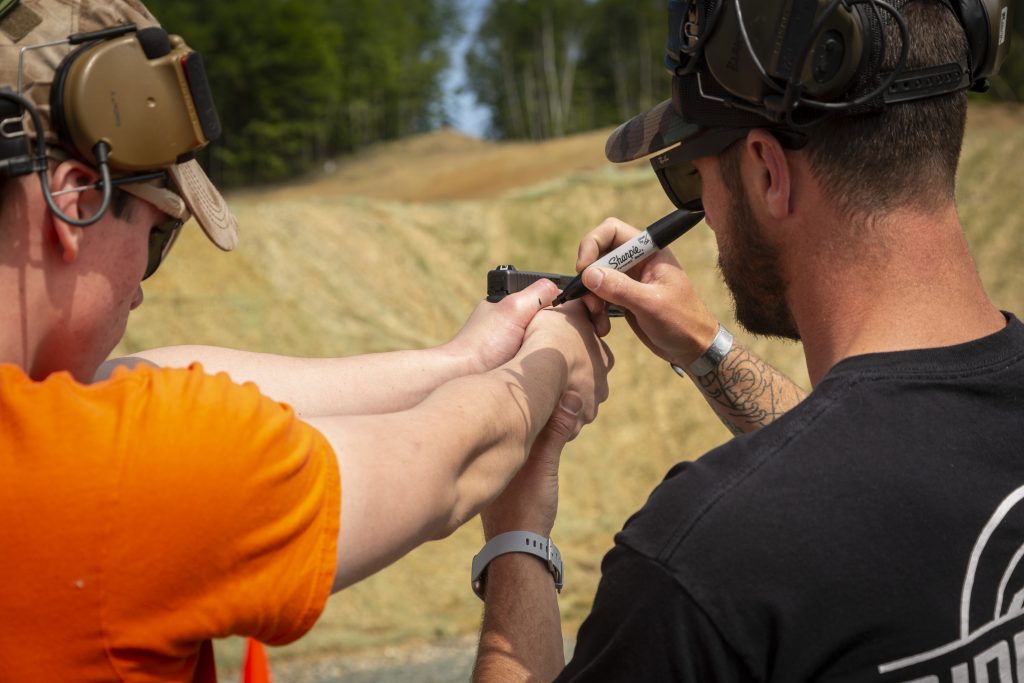
Time and Distance
Two tools instructors regularly use to assess and diagnose are time and distance. Real time pressure would come later in the class. Then Alex and Blake set us up to plug away at B8 targets at 25-yards. It’s a humbling distance for a lot of pistol shooters and it rapidly exposes deficiencies that need attention. B8 targets were punched 10 times, scores were counted, excuses were made, sights were adjusted, and the drill was repeated several times to establish a numerical baseline for each student.
Accountability
Ridgeline used scored paper targets throughout the first morning as a tool for the instructors and students to assess progress. This led to a lot of healthy, supportive trash talking among the students. It helped keep all our heads in the game.
Building Blocks
With sights fully adjusted and the marksmanship baseline established we continued to work at 25-yards for the rest of the morning. Instructors upped the ante with time constraints and multiple targets. Along the way a pattern developed where all the students were called into a school circle for a lecture that was followed by a drill putting the lectured material into practical use. The whole first day repeated this pattern covering things like gaining a firing grip on a holstered pistol, drawing efficiently, building a sight picture, following through (getting a second sight picture), reloading, and, of course, finding ways to get faster hits.
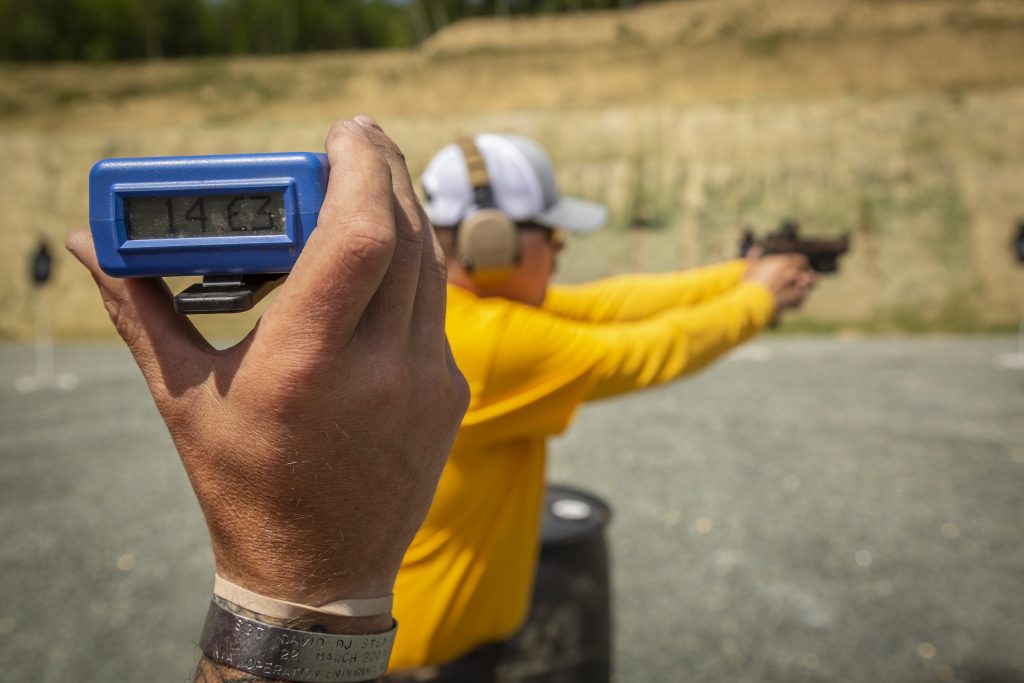
Add Pressure
Timers were used to add pressure, as were smaller targets and greater distances. The class transitioned from getting accurate hits on paper to getting fast and accurate hits on steel. The instructor’s subtext for day one was clear; focusing on good mechanics is more important than building speed. Speed will come.
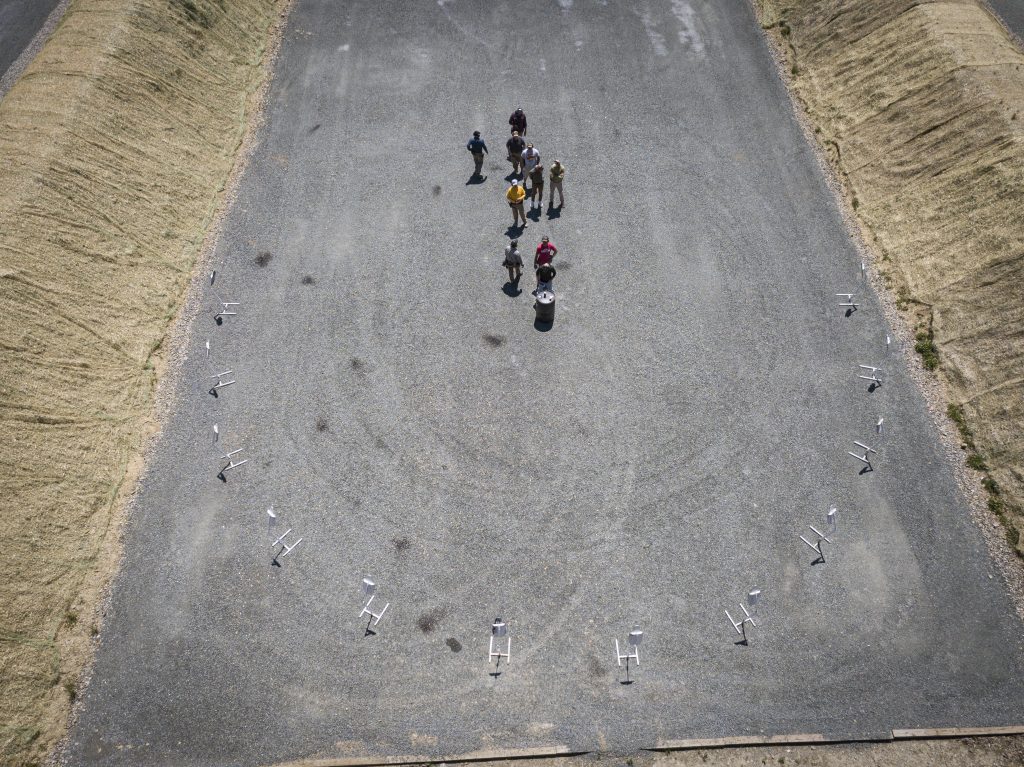
Put it Together
Day two put what we learned on day one into practice while on the clock and on the move. This was where the instructor’s home team advantage shines; steel. So much steel. Check out the photos and see the array of steel targets we were able to engage. From addressing targets in depth, to shooting around barriers, to running a nearly 180-degree fire zone to learn the importance of moving efficiently between multiple targets, there were multiple bays set up for individual lessons that absolutely maximized the student’s learning time. No students spent time moving targets around or waiting on the instructors to set up courses of fire. Three bays-worth of targetry were on tap so that no time was wasted in turning the first day’s “crawl” and “walk” lessons into the “run” portion of the class on day two.
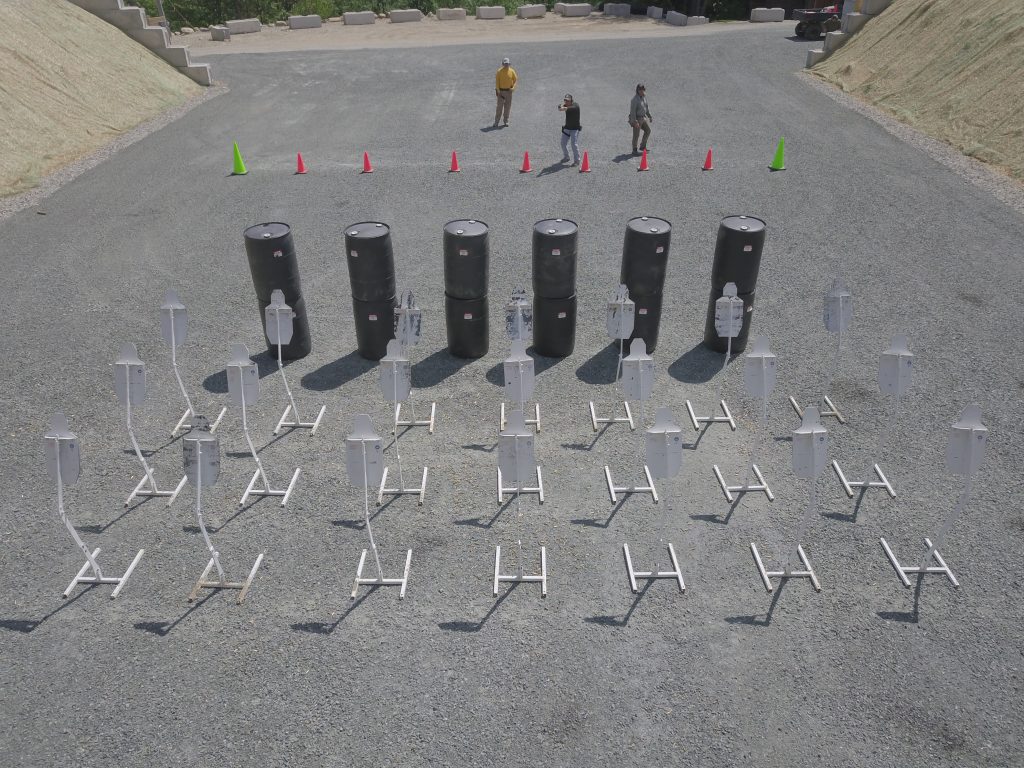
Capstone
At the end of day two, the instructors called everyone in for one last drill. It was a capstone event, pitting all the students against one another on the clock. The winner took home Ridgeline’s coveted Black Hoody. Winning the class shootout is the only way to get one. The cadre chose a drill that crystalized the fundamental skills we’d honed over the last 16 hours into a practical application; draw and shoot one on ⅔-size IPSC steel from 12 yards, fastest time with a hit wins. I can’t say that I drove home from New Hampshire with a black hoody. But I did get a sub-1.5 second hit drawing from concealment.
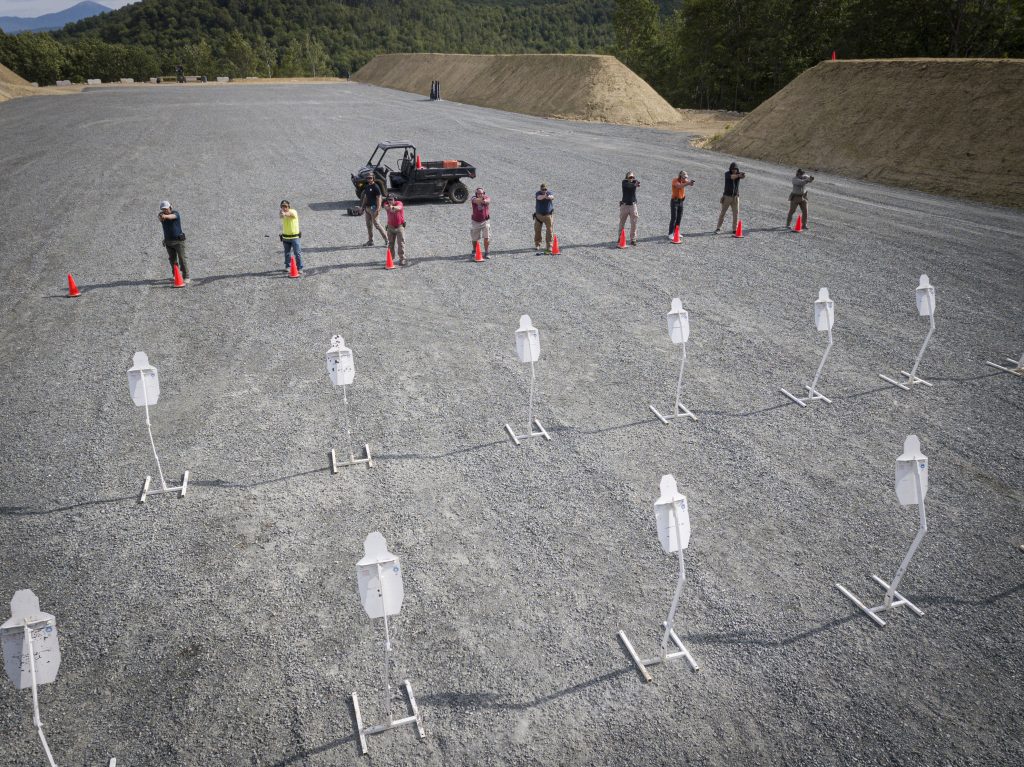
Wrap Up
At the end of the class, the students downloaded unspent rounds and took a few minutes of trunk time to put stuff away before heading into a school circle for the final words of wisdom from the cadre. This was also the time for class awards and a chance to ask any followup questions before hitting the road.
A multi-day shooting class is an immersive experience. It provides a load of new skills while reinforcing the fundamentals you’ve already got. With ammo prices as high as they are, it makes sense to maximize the value of every round you shoot. And, a great way to do this is to get to the range with a great shooting class.
Getting the Most From Your Experience
Pack Well – Get a gear list from the instructor for preparation. A good shooting school will have spares of commonly forgotten, lost, or broken items. But it’s always best to use your own gear so you’re focused on the lesson instead of fighting unfamiliar equipment. Packing well also means remembering things like sunscreen, ear and eye pro, rain gear, and note taking gear.
Dress Accordingly – Check out the weather report before you go. Wet weather isn’t going to shut down a training class. So, bring rain gear, including waterproof footwear. And bring a ballcap. Obviously, it helps keep the sun off your head. But it also prevents flying brass from getting behind your eye pro. It happens.
Factory Ammo – Don’t bring reloads. If you’re ready to shell out $1000+ for the class experience, don’t skimp on ammo. Nobody wants their class interrupted by a squibed gun. We’ve seen it happen. An advantage of taking classes with a school comes in the amount of resources they have on hand. This includes all-important ammo. If you’re having trouble finding ammo, ask your shooting school if they offer it as a training package.
Dump Pouch – Bring a dump pouch. For those that aren’t familiar with it, a dump pouch is just a small satchel that attaches to your belt. A big pocket for empty or surplus mags, it holds anything else that you not wanted in your pants pockets during class.
Take Notes – Bring a notepad and use it between drills to jot down your favorite drills to repeat when you’re home. Chances are, you’ll be onboarding so much info during the class you won’t recall the particulars of all the lessons and drills. If you don’t want to scribble notes, shoot video on your phone. Just make sure your cadre is cool with it and you’re not distracting other students.
Make Friends – Buddy up and help each other by shooting video during drills and compare notes during downtime. A little friendly competition during the class is a great motivator, too. Get contact information from your classmates and add them to your firearm knowledge network.
Bring Food – Pack a cooler or stop at a Wal-Mart and fill a cheap Styrofoam cooler with lunch for your class. Stay on the range while everyone else runs back into town for a meal. Reflect on the morning and fuel up for more training.
Ask Questions – Don’t be afraid to ask questions (when appropriate), or buttonhole your instructor after class or during breaks. Even the best instructors can get ahead of their students and a well-timed, “what about this,” can be a signal for them to step back and share an important point with the class.
